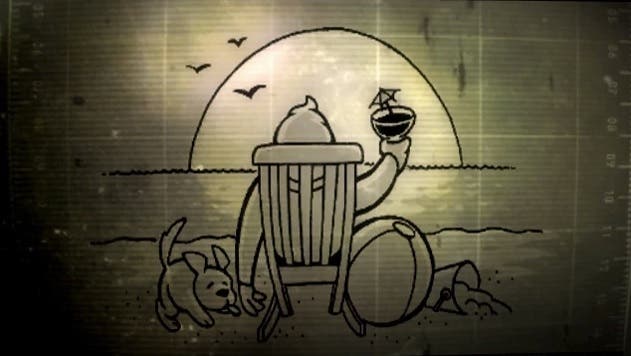The horror of Vault 11
"Congratulations, martyr!"
Nestled in the mountains, the door that leads to Vault 11 is the kind you see hammered onto a shack. It is rotting wood and nails and spider webs clinging on to existence like the people of Fallout's post-apocalyptic Mojave Wasteland. The Brotherhood of Steel have sent us here to find a differential pressure controller, one of the parts needed to repair their faulty air filtration system.
The Brotherhood said nothing about the horrors inside.
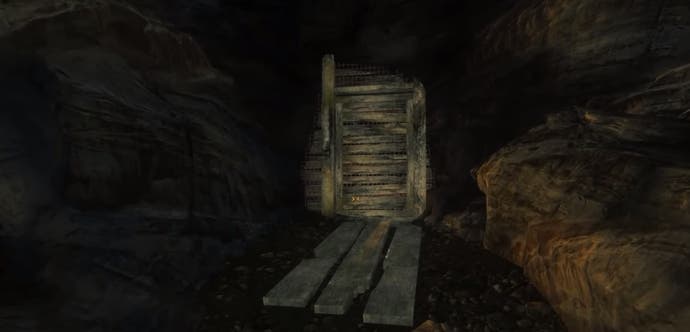
Vault 11 is unusual in that when you first arrive its main door, the one with the number 11 on it, the one would normally hiss and creak before pulling back and rolling sideways, is open. Most of the vaults you encounter throughout the Fallout games are locked shut, which makes sense. The vaults were designed to keep nuclear fallout out and happy dwellers in. Why is Vault 11's door open now?
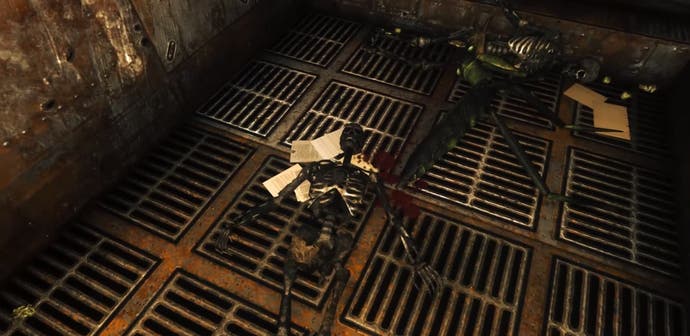
Through the main door, on the floor of a large entry room are four skeletons huddled together. Next to one is a 10mm pistol. Nearby is a terminal, one of Fallout's famous green-flickering lore boxes. On it is a security recording of the vault entrance.
Voice 1: Are we really gonna do this? It's open. We could just leave.
Voice 2: I couldn't. Not after that.
Voice 3: We don't deserve to leave.
Voice 4: "A shining example." That's what it called us.
Voice 1: But we were! We did what we were supposed to.
Voice 5: Not by a long shot.
Voice 1: Anybody would've done what we did.
Voice 2: You ask me, that's exactly the problem. Now let's get on with this.
Voice 3: I'll go first.
Voice 1: Wait. Wait. People should know what happened. They could learn from it.
Voice 5: If there's anyone out there at all, I hope they never have to find out. Ready, Harry?
Voice 3: Yeah.
Voice 1: No, no, no, wait!
Four gunshots in succession.
Voice 1: Whimpers.
Sound of a pistol dropping to the floor.
End of recording. What happened here? What drove four people to want to kill themselves? There are five voices on the recording but only four skeletons on the floor. What happened to the survivor of this apparent mass suicide? What happened to Voice 1, the whimperer?
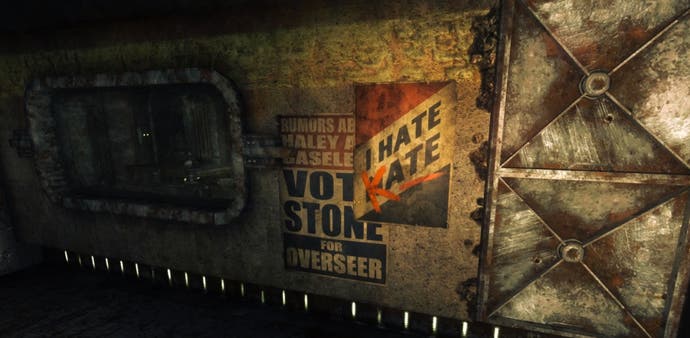
Splattered on the walls of the vault are posters - propaganda for what sounds like an election. But this election is different. It encourages you to vote for candidates who are, it seems, horrible, horrible people.
"Don't vote Glover. His family needs him!"
"Haley is a known adulterer and communist sympathiser. Elect Haley for Overseer."
"Rumours about Haley are baseless. Vote Stone for Overseer!"
"Glover has done nothing wrong. Vote for Stone!"
"I hate Nate."
Vault 11 initially baffles, but what's clear is its inhabitants were in the run up to an election to find the next overseer. This election, however, looks like it was broken. Instead of the election being about finding the best person for the job, it seems to have been about finding the worst person for the job. Why, exactly?
Vault 11 is my favourite vault in the Fallout series. When I first encountered it, in the thrilling days after Obsidian's wonderful Fallout: New Vegas came out in 2010, it took me by surprise. Its story unfolds like a horrific picture book, each room and corridor and terminal adding yet another layer of dread. And it made me think. It made me think about what it means to be human, the good, the bad and the very, very ugly. Eight years later, Vault 11 remains firmly rooted in my memory, as if it were a real place I once stumbled upon during a drug-fuelled road-trip from Los Angeles to Las Vegas, the kind of trip you taste on your tongue when you remember it, so stark were the events.
Like most vaults in Bethesda's Fallout games, Vault 11 is a maze of decaying corridors and stairways. Everything from the toilets to the clinic looks worse for wear, as if the walls and ceilings were dripping with entropy. Maintenance, a classroom, living quarters and all the other rooms needed to keep a small community of vault dwellers alive and kicking are present and correct - and creaking at the seams. Much of the place is window dressing - virtual innards that exist because they have to, because a vault needs to have these places for it to feel real, lived in and in the case of Vault 11, seemingly abandoned.
As always, the terminals hold the key. On them you find the Vault 11 election guide - a "handy" Dweller's Official Guide to Obtaining Overseers Democratically, or D.O. G.O.O.D. In it each of the three candidates is outlined, including a personal message. Here's Henry Glover, for example:
"I'm a devoted husband and father of six beautiful children. My oldest, Sam, was on the honour roll this quarter, and I couldn't be prouder of him. My youngest, Henry Jr., just said his first word, and it was 'Da-da.' We've got this bond already and he's still just a baby. Friends, when you go to the polls this election, I want you to think of your own children. Then I want you to think of Sam and Henry Jr. Picture their faces. Nate Stone should be overseer, not me."
The other candidates sound similarly desperate not to be elected. Why? You'd imagine the job of overseer would be one everyone wants, after all, the overseer is the boss, and you even get your own office. In Vault 11, though, things appear to work differently.
We then discover the upcoming election was postponed following a spate of murders. "God willing, if the killer is apprehended swiftly, we may have found a promising new candidate for overseer," writes Terry Hart, president of the Human Dignity Bloc.
Why would you want a murderer as overseer?
And then we read Overseer Order 745, penned by then overseer Katherine Stone, the wife of Nate Stone. As overseer, Kate scrapped the traditional democratic method of electing a new overseer each year in favour of random selection, "ensuring complete impartiality and fairness."
Downstairs, on the second floor of Vault 11, we find the personal terminal of Roy Gottlieb, the head of the Justice Bloc and the Chairman of the Coalition of Vault 11 Voting Blocs. On it is another recording, where two voices, one of which belongs to Roy, discuss Katherine Stone's termination of the election process. Roy wants to revolt, so unhappy is he with the random number generation Kate has put in place. This revolution would involve arming up to force Kate to return to the previous system, Roy reveals, but his companion expresses concern the other blocs won't tag along. The Justice Bloc, it turns out, has the majority and thus the political power in Vault 11 which has, for some time at least, meant they've been able to influence the annual overseer election. But if Justice Bloc take up arms, will the other blocs play ball or fight back?
It's here the story of Vault 11 takes a disturbing turn.
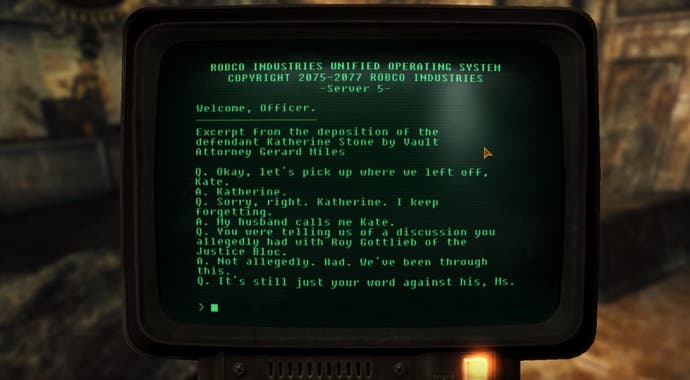
In security is a terminal that is home to a file called deposition. This is an excerpt of the deposition of "defendant" Katherine Stone by Vault Attorney Gerard Miles. In this conversation, Kate suggests the Justice Bloc were planning to endorse her husband, Nate as a candidate for overseer because he had beaten some of its members at poker. Kate then accuses Roy Gottlieb of asking her for "sexual favours" in order to prevent Nate from being endorsed. Sexual favours not just for Roy, but the entire Justice Bloc leadership and their friends.
Kate agreed. "What else could I do?" she says. This gang rape goes on for a month before the endorsements are released. Kate's husband, Nate, is on the list - despite the horror she had put herself through to save him.
Kate admits to being behind the murders that forced the election to be postponed. Enraged by the Justice Bloc's actions, she killed some of their members to thin out the leadership and reduce their majority. She reveals she expected to be caught. That was her best chance. Now the people will elect her, she says.
"A confessed murderer?" Gerard Miles utters in astonishment. "You think voters would be willing to risk putting you in charge?"
"They have to pick somebody and live with their reasons," Kate replies. "Wait and see."
Kate was right. She was elected as overseer, and immediately changed the rules.
At this stage, we still don't know why the inhabitants of Vault 11 are terrified of becoming overseer, but we do know that a new overseer is elected each year. Why? What happens to the old overseer?
Despite Fallout New Vegas being eight years old, the divisions that strike through Vault 11 feel entirely relevant in the here and now. In the age of Brexit and Trump and a politics most feel has spiralled out of control, Vault 11 and its bastard blocs and dirty elections all of a sudden feel uncomfortably close to home. I'm not sure what the moral of the story here is. I'm not sure The Wasteland is big on morals. I'm not sure the real world is either.
Deeper within the vault we find the reactor room, which is packed with skeletons hidden behind sandbag barricades. A battle took place here, but between whom? Was this Roy's rebellion? It looks like it. It looks like the bloody result of Roy's personal terror at the prospect of becoming overseer because a computer might randomly select him after years spent in control of his own fate.
In the atrium we find a terminal home to the prepared speech of Gus Olson, ombudsman for the annual overseer election. Olson ponders the election process, and what it really means for the people of Vault 11.
"We want it to make sense. To understand why the vault's mainframe will kill us if we do not offer one of our own as a yearly sacrifice. To fully comprehend why we continue to have these elections despite the unfettered corruption that has plagued it for what must be decades by now."
The vote for an overseer is the vote for a sacrifice. Vault 11 is an election for an execution.
"I can only wonder if there are no answers to be found," Olson laments, "and we are just going along with this because we don't see another choice."
Vault 11 is expert video game storytelling on the part of the designers at Obsidian Entertainment. Events are revealed slowly. It demands a patience on the part of the player. Much time here is spent exploring dead space, areas of the vault that contain no important documents, eye-opening terminals or NPCs who conveniently spell out the past for the bored or short of time. Instead, we pick up fragments of story via dweller logs and recordings, wonderfully written and then thoughtfully placed so that the player is likely to encounter each in the order planned by the designers. Environmental storytelling is used to good effect: the propaganda posters, the placement of skeletons, a solitary handgun, an abandoned room where the corrupt politics was conducted. We absorb Vault 11's truth via virtual osmosis. Then Vault 11 comes full circle, its conclusion leading into its introduction. It is a satisfying payoff, but not everything is explained. Mysteries remain.
There is nowhere left to go but the overseer's office. Via a terminal, we open the sacrificial chamber. The overseer's desk raises from the ground to reveal a stairwell that goes down. There is a trail of human blood and organs. There is a door. Behind it is a long corridor. At the end of the corridor is a light. There is light at the end of this tunnel, light that was seen by scores of overseers as they walked to their death.
And now you're following in their footsteps.
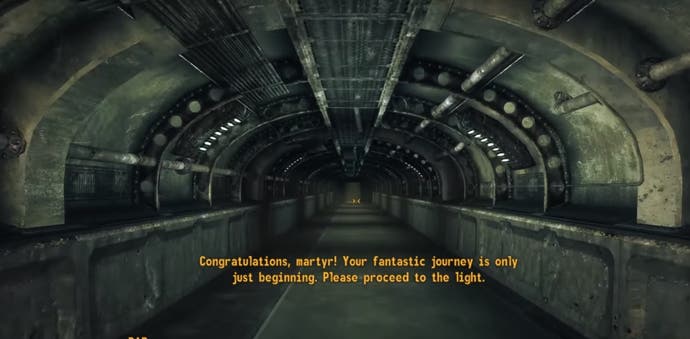
"Congratulations, martyr!" declares a chirpy male voice from some hidden speaker. "Your fantastic journey is only just beginning. Please proceed to the light."
We proceed to the light.
"The light is calming, and puts your mind at ease. Go to the light."
We go to the light.
Through a door we see four glaring construction lights in a room, then another door that leads to another room. In it is a chair sat next to a projector that faces a screen.
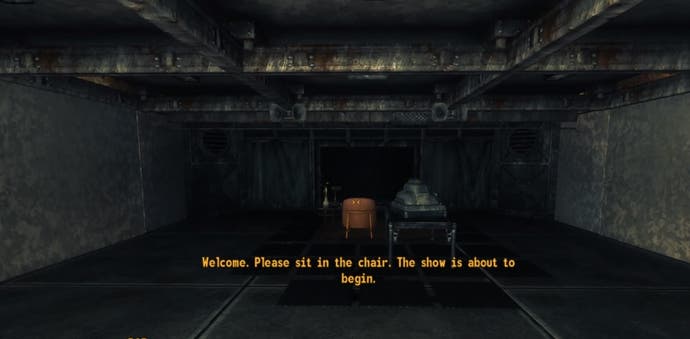
"Welcome. Please sit in the chair. The show is about to begin."
...
"The show requires that you sit in the chair."
...
"It is absolutely essential that you sit in the chair."
...
"You have no other choice. You must sit in the chair."
We sit in the ruined chair. The screen flickers into life. It is a presentation by Vault-Tec, the evil company that built Fallout's vaults, ostensibly life-saving chambers, in truth horrific social experiments - and Vault 11 is one of the worst.
The presentation, which includes voice over from the chirpy male voice from before, is a filmstrip in the iconic Fallout loading screen fashion. The chirpy male voice tells us our sacrifice means the vault can continue to thrive. We see a picture of a man on a beach, sitting on a chair, cocktail in hand, watching the sun go down. This is a two-minute film about our lives, but it has nothing to do with real life. This is the unobtainable, perfect 50s American life imagined by Vault-Tec. This is Vault-Tec at its most monstrous, trying to convince its latest victim - the player - to accept their death peacefully, as if they should be grateful. This is also Fallout at its monstrous best - unsettling, insane and kind of funny.
The lights go off and the walls of the room raise to reveal rock hard robots and ceiling-mounted turrets who immediately attack. These robots are not messing about, and take everything you've got - all your stimpacks, all your performance enhancing drugs and all the ammo you're packing for your most damaging weapon. You survive the encounter by the skin of your teeth, panting, confused and horrified. What just happened?
Vault 11 is also deeply troubling. Its end seems inspired by the Milgram experiment on obedience to authority figures, an experiment that involved working out to what extent people would violate their own morals when ordered to. Vault 11 teaches us people would be willing to go quite far in such a situation. In a wonderful, unexpected twist, we find ourselves walking in the overseer's shoes, somehow a part of the deadly experiment as a player in-game and out. We are the guinea pig, and we find that we obey. We sit in the chair and wait to die, just like all the overseers did before us. This, I think, is Vault 11's true genius.
The robots still smouldering, we notice the floor is littered with over a dozen human corpses, each an overseer sacrificed for the good of the vault because the people voted for them to die. We count 16 corpses, which means Vault 11's social experiment lasted for 16 years after the bombs fell. New Vegas is set around 204 years since the Great War of 2077. We arrive at the scene some 188 years after Vault 11 fell into chaos, after the armed rebellion swept death throughout the place. Everyone died - or so it seems.
Behind another door is the vault mainframe. This was the mainframe programmed to kill the entire vault unless it was given a yearly sacrifice. Inside a terminal we find a recording named Vault 11 Solution.
"All right, I know you can hear me, so listen up," says an unnamed man. "There's five of us left. Five. Out of... I don't know how many.
"So, it's over. We've talked and it's over. We're not going to send anybody to die anymore. So shut off our water or gas us or do whatever it is you're programmed to do. But we're done listening to you."
This man was one of the five people we heard in the voice recording we found at the entrance to Vault 11 - and it sounds like the man who tried to stop the suicide, the man who, we suspect, escaped.
There's something else, an "automated solution response", which the five survivors would have heard after making the decision to defy the mainframe.
"Congratulations, citizens of Vault 11!" declares the same voice from the room with the chair. "You have made the decision not to sacrifice one of your own.
"You can walk with your head held high knowing that your commitment to human life is a shining example to us all.
"And to make that feeling of pride even sweeter, I have some exciting news.
"Despite what you were led to believe, the population of Vault 11 is not going to be exterminated for its disobedience.
"Instead, the mechanism to open the main vault door has now been enabled, and you can come and go at your leisure.
"But not so fast! Be sure to check with your overseer to find out if it's safe to leave. Here at Vault-Tec, your safety is our number one priority."

Vault 11, we now realise, was yet another social experiment by Vault-Tec, which wanted to see how far vault dwellers would go under order of an authority figure. When the five survivors we hear in the recording found at the entrance to the vault learned of this, when they realised all of the backstabbing, the politics, the threats, the fighting, the stress, the terror, the rape and the murder were based on a lie, they were so ashamed of their actions that they felt there was no option but to commit suicide. Better that than the true story of Vault 11 ever come to light.
Maybe Voice 1 felt differently. Maybe he felt the true story of Vault 11 had to come to light, to educate, to help prevent something like this from ever happening again. Did the other four try to silence Voice 1 after he refused to commit suicide? Did Voice 1 kill them in self-defense? Did Voice 1 murder them in order to save himself? Or maybe the other four committed suicide, as it first appears when we enter the vault and view the scene, hundreds of years later. We simply don't have all the answers. All we know is Voice 1 was the sole survivor of the horror of Vault 11.
Everyone else died.
Vault 11 starts with a bang - four in fact - and it gets better from there. In the slow exploration of the long abandoned place we learn the story of its people and the events that led to the incident at the entrance. It is a rollercoaster ride light on combat - save the killing of the odd mutated rat and the cacophony of chaos at the climax - but heavy on story. The peaks are packed with intense anxiety that hurtle toward revelatory troughs. There are moments throughout, such as when you learn what Katherine Stone put herself through for her husband, and, well, pretty much everything that has to do with the sacrificial chamber, that live long in the memory. Vault 11 is, quite simply, Fallout at its very best, another example of a seemingly innocuous quest leading to something surprisingly intricate and entrancing. (Don't forget to pick up that differential pressure controller, by the way.)
Behind the horror of Vault 11
Vault 11 designer Eric Fenstermaker speaks about the making of the human condition.
Eric Fenstermaker is a writer and designer who worked at Obsidian Entertainment for over a decade before leaving to go freelance. He had a hand in Neverwinter Nights 2, Neverwinter Nights 2: Mask of the Betrayer, Fallout: New Vegas, South Park: The Stick of Truth, Pillars of Eternity, Pillars of Eternity: The White March Parts 1 and 2 and Pillars of Eternity 2, writing, designing levels, scripting and playing with gameplay systems design. He got his start in college as a summer programming intern at Pipeworks Software in Eugene, Oregon, working on a couple of Godzilla fighting games. "I was a big Godzilla fan growing up, so it was a pretty great introduction to the industry, and everyone there was just really cool to work with," he tells Eurogamer.
Obsidian was Fenstermaker's first job after college. He inched his way into level and narrative design over time after joining as a gameplay scripter. New Vegas was about halfway into his time at the studio. "At that point I was a level-designer-who-was-allowed-to-write-his-own-stuff," he says. "That's a good job because the ratio of creative freedom to overall responsibility is very favourable."
More recently, Fenstermaker wrapped up work on Pillars of Eternity 2. "I remained narrative lead through pre-production, and then I moved out-of-house to work as a part-time contractor instead," he says. "So I ended up writing a companion, Edér, for that project over this past year. He was a lot of fun to write in the first game, and the other writers on that team are terrific to collaborate with, so doing him for the sequel was a no-brainer to me."
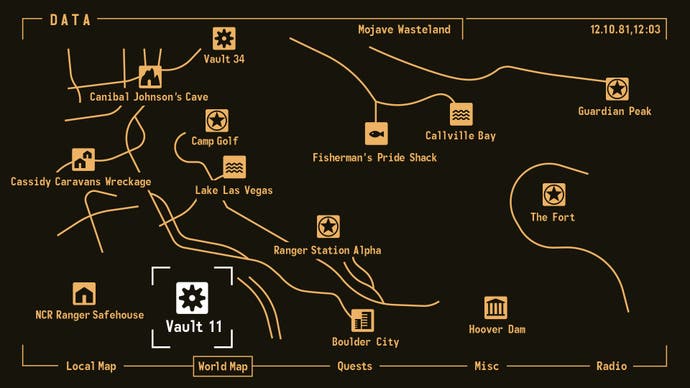
What were the inspirations behind Vault 11?
Josh Sawyer, who was the project director, walked into my office one day and told me I was going to be doing Vault 11 and it should take inspiration in some fashion from Shirley Jackson's short story, The Lottery.
I had never read it, and I resolved at that point it would be better if I didn't read it as part of the research, just because I wanted the narrative of the level to stand on its own and not be some kind of rehash - even subconsciously. All I had to go on was the basic description Josh gave me, which was that the story was about a small town where every year they choose a person at random and stone them to death. (I think. I really should read it at some point.) So I started thinking about what an annual execution would look like as a social experiment.
What was the initial idea for Vault 11, the top level conceit you were going for?
Everything came out of trying to envision what a community might do if they were forced to murder one of their own every year. What kind of system would they settle on? It occurred to me that, while random selection would seem to be the fairest approach, it probably wouldn't have sat well with people. I figured they'd want to believe they had some kind of control over their circumstances. And the more aggressive types would work quickly toward a structure that they could manipulate in their favour.
A democratic framework would probably be the path of least resistance in that regard - it sounds fair on its face, it's an American ideal - especially for that generation, it minimises individual guilt over the decision, and it allows for a rationale. A random selection could mean you, could mean your kid. A democratic choice, you just have to not be the most hated person in the vault that year. That is something you could see an entire community getting behind, and it's also of course easily corrupted and manipulated.
So the reverse election became the foundation of the story. And with Fallout, you always have this pairing of willful 1950s naivete with the stark, brutal realities of human nature. So a lot of the joy for me came from bringing in trappings from the postwar era, and at the conceptual level I thought it would be fitting and fun if we found out at the end that Vault-Tec had made a quaintly optimistic hypothesis about the experiment's outcome and then been proven horribly wrong.
How much reference work did you make when preparing Vault 11?
The design document itself wasn't extensive. It was all text, and I think much of it was devoted to an overview of the narrative, and an explanation of the order in which it would be experienced.
The rest of it was art and sound requests. Since it was a vault, most of the level art came from preexisting Fallout 3 tilesets, so I focused my art requests on smaller things that would create the right atmosphere. I caught wind that legendary Fallout artist Brian Menze, a few doors down, was not overly busy at the time so I saddled him with a ton of requests for 50s-era campaign and recruitment posters, as well as the filmstrip slides. (Some of the posters got blown up and printed out and they're still hanging at Obsidian in their common area.)
Tell us about the design process. How do you go from a cool idea to it being this cool place in the game?
I spent almost all my time trying to work out the plot and how the level would progress it. I never got it quite as clean as I'd have liked, but the design took longer than it was supposed to as it was, and various managers had begun breathing heavily down my neck, so I had to run with it.
Implementation was fast. Compared to my other levels, I spent hardly any time on it. For all the flack that engine gets, the level design tools are very efficient, and you can lay out a vault in no time. I don't think many of our design documents even included layouts (or maybe it was just me), because our schedule was so tight and because in many cases was just easier to build out the interiors and iterate on them in-game.
Is there some Fallout lore reference book you could refer to to ensure Vault 11 made sense in the Fallout universe? How much freedom did you have when creating the vault and the characters in it?
There was no book. We had a few ex-Black Isle guys like Josh who had been part of the early games in the series, and knew the setting really well. They were always helpful when questions came up.
The nice thing about the vaults though is they have very little baggage to them in terms of lore. With Vault 11 I really had carte blanche when it came to narrative choices. As long as I got the tone right, it was going to feel like it belonged.

What kind of experience did you hope the player to have in Vault 11?
There were a few goals. I wanted the whole thing to be structured as a mystery where players would see the outcome first and then progress through the level trying to learn the reason for it. So the first point of interest the player is meant to come across is where the "survivors" lie, near the entrance.
From there, I wanted things to get stranger and more opaque before they became clearer, which is maybe a dubious goal for a narrative designer. The hope was to make it very difficult at first to imagine what on earth these people could have been up to, so when the story all slowly came together, the revelation would hopefully be satisfying.
And then, towards the end, I wanted the player to walk in the shoes of the former overseers, with only the vaguest idea of what was in store, and maybe the dim hope that the "sacrificial chamber" would just be a secret exit from the vault. I did also have some notion that I wanted the path to the sacrificial chamber to feel half like you had just died and half like you were about to get on a ride at Disneyland.
More broadly, there's kind of an essential Fallout feeling that you get when the game is hitting all the right notes that are the basis for the IP. It'll come in a level, or an encounter, or a moment. You can't really get it anywhere else. Fans will know what I mean. In the back of my mind, that's probably what I was chasing above anything else.
How do you approach designing the layout of the vault so players are likely to discover its secrets in the way you hope?
I took it level by level. The top level was about establishing the overarching mystery and the election structure, and introducing some of the major characters. Further down, you'd learn about the corruption, and about Katherine Stone doing something to upset the order. Then at the bottom you'd see the outcome, both in the writings and in the physical evidence of armed conflict, and you'd get a complete explanation of the history of it all. At that point you'd understand what had gone down, but the question of the survivors' actions would still remain. Thus the sacrificial chamber was set up to come last, so that only after sharing in the overseers' experience would they "earn" the answer to the puzzle.
It's a perpetual bane of a level designer's existence that you can lead players to water but you can't make them drink, so you have to operate under the assumption that they're liable to miss a great deal of what you wanted them to see. That's why there's a lot of redundancy in the computer terminal entries - if you missed the important stuff on the top level, you'd still be able to read it on terminals in the second level. By the time you get to the bottom, those computers have just about every bit of important information on them.
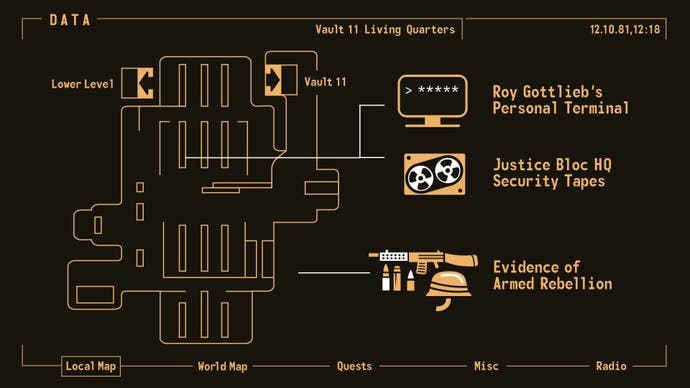
The most tragic character in Vault 11 for me is Katherine, who endures unspeakable horror to try to save her husband. Can you tell us more about this character, her inspiration and role in the story?
As I was figuring out the backstory, one of the main questions to answer was, what changes? Why do they stop sacrificing themselves, and finally stand up to the vault's computer system? One answer that seemed conceivable was that it might be because an insurrection had killed most of the inhabitants. The whole situation was so ripe for conflict. It'd only take one person to to seize upon everyone's disillusionment with the process and upset the balance. In that regard, someone with a strong connection to one of the overseers-to-be-sacrificed made sense. So Katherine was conceived as the person who had finally said, "Enough."
I think I took her last name from Donna Stone, who was the main character of The Donna Reed Show. (I used to watch a lot of old sitcom reruns as a kid.) Donna Stone was the quintessential '50s sitcom housewife, with the house dresses and the pearls and idealised family and the whole bit. And that was sort of what Katherine became for me - a kind of Fallout funhouse-mirror reflection of Donna Reed's character. Donna Reed as a vigilante revenge killer.
The combat end of Vault 11, when you experience the fate of the Vault 11 overseer, is one of the most memorable moments I have from the entire Fallout series. It was not only tense and terrifying, but difficult to survive! On this, where did the idea of having the player sit down and listen to an authoritative voice explain your fate come from? Was it, as players suspect, a Fallout take on the Milgram experiment on obedience to authority figures?
I had the idea for the filmstrip first. I wanted something funny there, partly for pacing, partly because it'd be the right mode for Vault-Tec, and partly to get players to drop their guard. I liked the thought of some last bit of social control being exerted on the part of Vault-Tec to get the victim to accept their death peacefully, as though that were somehow more humane, or that someone would actually ever overcome their fear of death thanks to an absurdly generic two-minute filmstrip about their life. I knew we had the framework to do a filmstrip from the Fallout 3 G.O.A.T character generation test, and I thought something in the vein of a '50s health class film on puberty would be about the right level of condescending.
The background music in that filmstrip was originally this very serene piece - something that was in the Fallout 3 legacy music, but somehow it got changed by someone else to something more jaunty, and I didn't catch the change until it was too late. I much preferred the original for the mood it set - it really lulled you to sleep before the walls opened up.
With the execution, I was just going to have the room be a gas chamber, but then I realised it'd be much better if for some reason their plan for killing the sacrificial lamb was just the messiest, most over-the-top and inefficient method possible.
The Milgram reference I added during implementation. Early on in the design phase, I had looked into social experiments that might provide me with a kind of proof-of-concept for Vault 11, so Milgram came up, the Stanford Prison Experiment came up. And they seemed to suggest that Vault 11's situation was, sadly, quite plausible in the right conditions. (Just as importantly, they provided insight into the mentality of people who design and run such experiments.) Later, when I was implementing the sacrificial chamber, I wanted the player character to actually have to sit down in a comfy chair to watch the filmstrip, and that required a VO prompt. In the interests of having the player experience what the sacrificial overseers had experienced, it seemed appropriate to goad a hesitating player into going along with authority, Milgram-style. Any player who sat down was doing so despite the fact that they always had the option to walk out.
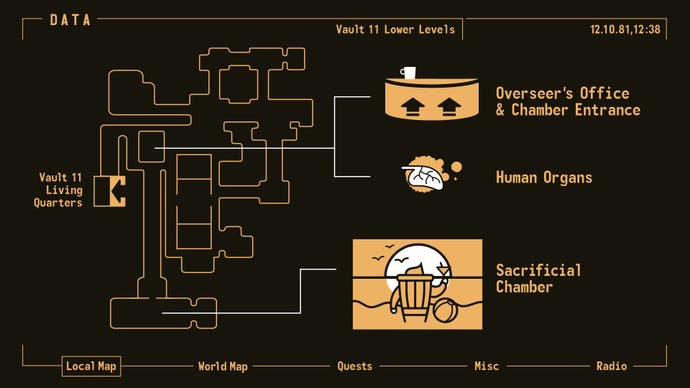
Do you have any data on what percentage of players died the first time they robots came out of the walls? (I suspect it's a high percentage!)
I don't. The stat I would really want is how many people made some kind of audible yelp or peed or something when it happened. As a designer you want to know that your work is making a difference out there.
It sounds like there is one survivor of Vault 11, who we presume leaves. Did you intend for this character to pop up somewhere else in the game? If so, what was their fate, and how come they didn't make the cut?
There are so many good fan theories on the identity of the character that I don't want to put any of it to rest. At this point I think what a player imagines happened to the survivor is far more personal and satisfying than anything a developer answer would provide.
Does Vault 11 contain any secrets players have yet to uncover, any elements players have yet to fully understand?
Just the stuff about the mysteries of human nature. But these days, there's probably a reddit thread or something where somebody figured all that out too. Same way they figure out what's going on in Westworld.
Does the Vault 11 story end on an optimistic note, because eventually the vault dwellers break the chain of sacrifice, or is it an essentially downbeat ending, because even with freedom beckoning pretty much everyone ends up dead?
This is just the sort of question I would want players to be asking when they finish the vault!
What does Vault 11 say about the human condition?
If I told you it would take all the fun out of it. I'm not saying that to be an ass - it's really kind of true. Sometimes content creators do their consumers a disservice by demystifying their work too much. And sometimes the creators are wrong, too.
And finally, what makes a great Fallout vault, and why does Vault 11 work so well?
For me, a vault is kind of a perfect microcosm of the Fallout setting. Elsewhere in the wasteland, you might have a level that's just about fighting ghouls, or raiders, or supermutants. But the vaults, via Vault-Tec, always bring in that post-World War 2 cultural element that makes the setting what it is. That was a time of great optimism and imagination on the one hand, but whitewashing, denial, and paranoia on the other. It's great material to draw from, and I think a lot of successful vaults make good on the opportunity. If you took that element out of Vault 11, I'd imagine you'd be left with something comparatively bland.
The other thing is, there's something inherently fascinating about social experiments. They satisfy one of our most basic curiosities. At the end of the day, as long as the vault has an interesting experiment (assuming it's not a control vault), you're gonna want to know how it played out.
Illustrations by Anni Sayers.
